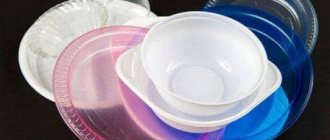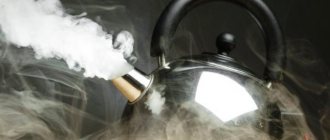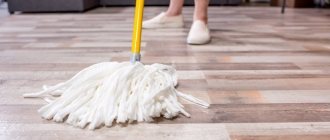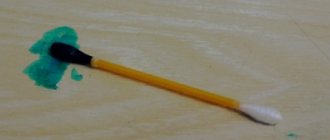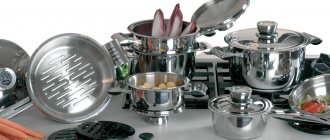Stainless steel kitchen utensils are very beautiful and easy to use.
That is why it is so popular among housewives. But after a while, dirt appears on the dishes and it loses its shine and cleanliness, as well as its functional qualities. If you know how to wash stainless steel dishes from black deposits, then you don’t have to worry about their appearance and functionality. REFERENCE! The alloy used in the manufacture of tableware is not subject to corrosion, and was discovered to the whole world by the Englishman Harry Brearley. The production of stainless steel cookware began in France, after which such utensils very quickly became popular throughout the world.
Basic rules for cleaning stainless steel cookware
There are certain rules. Knowing them, questions like how to clean dishes will not arise. Let's look at the basic rules:
- Regular cleaning of dishes will help maintain their original appearance;
- use modern detergents, remembering to rinse them off with running water;
- Stainless steel should not be washed in the dishwasher, it is better to use the manual method, and the auxiliary means: a soft sponge and detergent;
- wipe the dishes with a dry cloth after washing, this way you can avoid drips;
- rubbing is carried out with point movements (dipping), but not in a circular manner;
- You can restore the previous shine by using potatoes cut in half.
You need to clean dishes according to certain rules.
It is strictly not recommended to: use abrasives, scrapers and hard sponges.
What not to do
Now that we’ve sorted out the recommendations for proper cleaning of dishes, it’s time to move on to tips on what is not recommended to do. Please read the tips below carefully:
Scrapers
This is the main enemy for pans. When trying to get rid of carbon deposits, especially stubborn ones, the idea of using metal scrapers may seem like a good idea, but this is a misconception. After all, along with soot, you can literally scrape off part of the surface, which cannot be restored.
Scrapers can scratch the surface of the cookware.
Powders and abrasives
Powder products and hard sponges with a rough surface have a similar effect.
Do not use abrasive products.
Aggressive alkaline or acid-containing compounds
Such means may not cause any harm, but playing roulette is not always correct.
Note! It is best to use soft sponges and gel detergents.
It is recommended to use soft sponges and detergents.
Possible contaminations and their causes
During operation, the cookware comes into contact with food, water, fats, and acids. On the surface, in addition to food, other types of contaminants are formed.
Nagar
During cooking, fat splashes onto the internal and external surfaces of the cookware. First they create a thin yellow film. It's sticky and durable. If it is not removed, carbon deposits will form on the surface. It is a dark, thick crust.
"Rainbow" on the bottom and walls
Rainbow stains appear on the bottom and walls if an empty pan is overheated. Under the influence of high temperatures, the protective film on the steel surface thickens. It creates the rainbow effect. The operational properties of the product are preserved.
Scale
Limescale appears on the bottom of a kettle or pan. It means the water is hard. It contains mineral salts. The color of the plaque depends on what minerals are dissolved in the water. It can be white, gray, red.
How to clean the inside surface of a stainless steel pan from carbon deposits
When cooking, carbon deposits can form not only outside, but also inside the pan. And if external contamination is mostly a matter of aesthetics, then internal contamination makes the pan practically unsuitable for further use.
The carbon deposits formed inside the cookware make it practically unusable.
Let's look at the most popular sources of problems with the inner surface of cookware and ways to eliminate them:
Burnt porridge that was forgotten
This happens quite often. The first step is to fill the pan almost completely with water and place it on low heat. As it boils, you need to carefully peel the porridge from the walls.
If the porridge is burnt, fill the pan with water and put it on fire.
When there are no solid particles left, drain the contents and, using folk remedies or household detergents, complete the cleaning.
You can complete the cleaning using folk or store-bought remedies.
Burnt from potatoes
We were cooking potatoes, got distracted, and when we remembered, we saw an unpleasant picture - the inside of the stainless steel cookware had turned completely black. Here the contamination will be more difficult to remove. But you need to act according to the same algorithm as in the previous paragraph.
Burnt from potatoes can also be removed by boiling.
The stainless steel frying pan is burnt
Unlike saucepans, frying pans can have a non-stick coating. But this cannot provide 100% protection against burning. If this happens, use the cleaning recommendations presented in the first paragraph and do not forget about a detergent that can handle grease.
There can be many options for why stainless steel cookware burns. But the most important thing is not to overdo it when trying to clean it and not damage the surface. Especially when it comes to non-stick pans.
A stainless steel frying pan can also burn.
Adding shine
You can restore the original appearance of stainless steel kitchen products and extend their service life by polishing.
The procedure is carried out as follows:
- A soft sponge is soaked in vinegar or a special product designed for polishing steel, then the dishes are wiped with it. You can also use lemon juice. Before use, the juice is diluted in the following proportions: 1 tablespoon of juice per 1 glass of water.
- The polished dishes are washed with clean water and wiped with a dry towel.
- If you wipe a pan with raw potatoes, its surface will become glossy.
Cleaning the external surface from burning
There are different ways to clean the outer surface of a pan from carbon deposits: traditional methods, cleaning and detergents. There are a lot of options, but some of them are especially effective in combating specific types of pollution. For example, if we are talking about fatty products, you will need to use specialized detergents.
The outer surface can be cleaned with both folk and commercial products.
It's no secret that boiling can greatly simplify the process. Residues are cleaned with soft sponges. But there are special types of pollution. For example, jam. We'll look at how to deal with them below.
How to properly care
In order not to look for how to clean stainless steel from dark stains, it is important to remember the rules of care. After each cooking, carefully remove any remaining food and fat from the dishes. During heat treatment, food should not burn to the bottom. Leaked traces are removed from both the utensils and the cooking surface of the stove.
The joints of the handles are the vulnerable part of the cookware. When washing with aggressive chemicals labeled “anti-grease,” you should not apply them to these areas. Contact with an unfavorable environment may cause corrosion stains.
Features of care Source takprosto.cc
Cleaning features depending on the type of burnt food
Often it is not possible to keep track of porridge, soup, stew... In all cases, the result will be approximately the same - streaks form, which subsequently burn. But it is most likely that milk or jam will escape. If in the first case there will be no problems with eliminating drips, then with jam everything is more complicated. Sugar in the composition and other substances will melt and eat into the surface.
Sugar or jam is the most difficult to eliminate.
How to get rid of burnt jam, several methods:
- Apple peel copes with this task quite effectively, since it contains acid. The peelings should be dipped in water, and the pan that is burnt on the outside should be placed in a larger container. Bring to a boil and turn off after 15-20 minutes. Then let the container cool and rub thoroughly with a wooden spatula. This way you can get rid of the main contamination.
- Serum has a similar effect. Buy several liters of the substance and, without diluting with water, repeat the procedure described above.
Burnt jam can be removed with apple peel or whey.
In addition to folk remedies, special detergents also show high efficiency. Some do better, others less well. It is best to objectively consider the most effective ones in order to select them for your situation.
To clean the pan, you can resort to various detergents.
Characteristics of raw materials
Stainless steel is an alloy based on iron with alloying additives (chrome, nickel, steel). Each additive enhances the positive and reduces the negative parameters of the raw material. The resulting metal is much stronger than conventional analogues.
Advantages of the material Source ua.all.biz
Corrosion resistance is the main advantage of modified iron. When exposed to oxygen, chromium forms a thin layer of insoluble oxide on the surface. The film makes the alloy inert towards aggressive substances. The barely noticeable protection prevents the metal from entering into chemical reactions with the environment.
Nickel in the composition gives the alloy ductility, viscosity at low degrees and increases heat resistance. The material has a wide operating temperature range. The additive reduces the spread of spot and contact rust. Durable modified steel does not collapse when:
- stretching;
- welding;
- bending;
- rental
The best chemicals
There is a conditional division of cleaning products into household and professional. The latter are used by cleaning companies and are effective, but expensive. For home use, it is best to pay attention to the available options that will help cope with contamination. Among them:
- “Amway” (positioned as a natural composition, absolutely safe for humans);
- "Mr. Myscul";
- “Master Cleaner” (similar in effect to the previous product);
- "Chister" and others.
Pay attention to the instructions left by the manufacturer on the packaging. Profile ones (for cleaning stainless utensils) will show more productive results.
Methods of cleaning using traditional methods
Many detergents on the market that can cope with problematic stains in the form of carbon deposits are available for purchase. But you don’t always have the desire or opportunity to go shopping. In this case, folk methods - proven in practice over generations - will come to the rescue. Some of them are so effective that they do not require “additional advertising.” Let's look at the main methods.
Sometimes a pan can be saved using folk methods.
Salt
This product is used not only in cooking for preparing foods. With its help you can get rid of soot. Considering the low cost of salt and its availability in almost every home, it is still worth trying to test the method in practice. We perform the following algorithm of actions:
- fill the pan with water and leave to simmer for several hours;
- if the deposit is outside, then you will need a larger container into which you can place a contaminated stainless steel pan and fill it with water;
- drain the water, apply a layer of salt to the walls (in the soot area), rubbing in a little;
- After a few hours, wash off the salt and wipe off the carbon deposits with a soft sponge.
Before cleaning with salt, you need to fill the pan with water.
The proportion of the salt layer, if you decide to use a solution, is 1.5 kg per 5 liters of water. With the help of a solution you can sometimes deal more effectively with contaminants. But the method involves boiling.
Lemon acid
Everyone knows that you can get rid of scale in a kettle, rust and other types of dirt using citric acid. It can be called not only a food additive, but also a cleaning agent for all occasions, and carbon deposits are no exception. It's quite simple to use:
- pour a packet of citric acid into the water, stirring and pouring into the pan;
- put the dishes on gas, bring to a boil;
- 20 minutes after boiling, remove from the stove;
- Without pouring out the contents, let the solution cool;
- Using a sponge and detergent, remove any remaining carbon deposits.
Citric acid can be used not only for food.
An alternative to powder can be lemon juice. It can be applied to the burnt surface and let the acid work. Then we simply wash it off as in the algorithm of actions described above.
Soda and silicate glue
The interaction of soda and silicate glue in the right proportions helps eliminate even complex contaminants such as carbon deposits. To prepare the composition you will need:
- 100 g of glue (you can use PVA, stationery, silicate);
- 5 liters of water (as the main solvent for the composition);
- half a pack of soda (regular, table).
Silicate glue in combination with soda will help cope with carbon deposits.
The listed components are mixed, and the effect can be enhanced by adding detergent. Using a large container, immerse the pot or pan that needs to be cleaned into it. and then fill it with a pre-prepared solution. Bring to a boil and do not remove from heat for 20 minutes. Let the liquid cool. The carbon deposits come off with little effort (we use an ordinary sponge).
After boiling, the carbon deposits come off without much effort.
Boiling method with vinegar and laundry soap
A simple but effective method involves a boiling process. The active ingredients are laundry soap and vinegar. Preparing the solution is quite simple: rub the soap on a grater for faster dissolution in water. Pour into a container with water and add vinegar (200-300 grams per 5 l). Fill the dishes that need to be washed with the solution. Place on fire and boil for 20-25 minutes.
Drain the solution when the water has cooled. Using detergent we get rid of carbon deposits.






